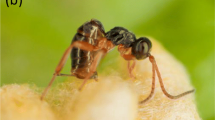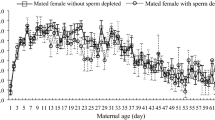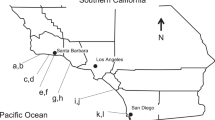Abstract
Natural populations of the cosmopolitan polychaete species, Capitella capitata (Species Type I, Grassle and Grassle 1976) contain males, females and hermaphrodites. Hermaphroditic individuals arise through feminization of males when females are rare. The age-specific survivorships and fecundities of females and hermaphrodites were estimated. There were no significant differences between females and hermaphrodites in survivorship, number of offspring per brood, or percentage of aborted eggs per brood. Net reproductive rates were used to estimate fitness, and the relative fitness of a hermaphrodite as a female ranged from 0.09 to 0.31. The fitness differential was due to the difference in the number of broods that females and hermaphrodites produce. The effects of density, sex ratio, age and body size on the timing of the development of hermaphrodites in groups of siblings were also examined. Hermaphrodites appeared when females were rare or when densities were low. Hermaphrodites never developed in cohorts with larger males unless females were rare. These observations suggest that feminization of males occurs when some males are unable to gain access to females because of mate competition. Feminization does not appear to be correlated with a threshold in body size.
Similar content being viewed by others
Literature cited
Bacci, G. (1965). Sex determination, Pergamon Press, New York
Bacci, G. (1978). Genetics of sex determination in Ophryotrocha (Annelida. Polychaeta). In: Battaglia, B., Beardmore, J. A. (eds.) NATO Conference Series IV, Marine sciences, Vol. 2, Marine organisms: genetics, ecology, and evolution. Plenum Press, New York, p. 549–571
Bateman, A. J. (1948). Intra-sexual selection in Drosophila. Heredity, Lond. 2: 349–368
Bull, J. J. (1981a). Sex ratio when fitness varies. Heredity, Lond. 46: 9–26
Bull, J. J. (1981b). Evolution of environmental sex determination from genotypic sex determination. Heredity, Lond. 47: 173–184
Bull, J. J. (1983). Evolution of sex determining mechanisms. Benjamin/Cummings Publishing Co., Menlo Park, Calif.
Bulmer, M. G., Taylor, P. D. (1980). Dispersal and the sex ratio. Nature. Lond. 284: 448–449
Charlesworth, B., Charlesworth, D. (1978). A model for the evolution of dioecy and gynodioecy. Am. Nat. 112: 975–997
Charlesworth, D., Charlesworth, B. (1979). The evolutionary genetics of sexual systems in flowering plants. Proc. R. Soc. (Ser. B) 205: 513–530
Carnov, E. L. (1982). The theory of sex allocation. Princeton University Press, Princeton, N. J.
Charnov, E. L., Bull, J. J. (1977). When is sex environmentally determined? Nature, Lond. 266: 828–830
Charnov, E. L., Maynard, J., Smith, Bull, J. J. (1976). Why be an hermaphrodite? Nature, Lond. 263: 125–126
Fischer, E. A. (1981). Sexual allocation in a simultaneously hermaphroditic coral reef fish. Am. Nat. 117: 64–82
Fischer, E. A. (1984). Local mate competition and sex allocation in simultaneous hermaphrodites. Am. Nat. 124: 590–596
Franke, H.-D. (1986). Sex ratio and sex change in wild and laboratory populations of Typosyllis prolifera (Polychaeta). Mar. Biol. 90: 197–208
Ghiselin, M. T. (1969). The evolution of hermaphroditism among animals. Q. Rev. Biol. 44: 189–208
Grassle, J. F., Grassle, J. P. (1976). Sibling species in the marine pollution indicator Capitella. Science, N. Y. 192: 276–284
Grassle, J. P. (1980). Polychaete sibling species. In: Brunkhurst, R. O., Cook, D. G. (eds.) Aquatic oligochaete biology. Plenum Press, New York, p. 25–32
Gross, M. R., Charnov, E. L. (1980). Alternative male life histories in bluegill sunfish. Proc. natn. Acad. Sci. U.S.A. 77: 6937–6940
Hauenschild, C. (1959). Weitere Kreuzungsversuche zur Frage der Geschlechtsbestimmung bei dem Polychäten Grubea clavata. Z. Naturf. 14: 89–92
Holbrook, M. J. L. (1982). Hermaphroditism as a reproductive strategy in Capitella. MS thesis, Dalhousie University
Holbrook, M. J. L., Grassle, J. P. (1984). The effect of low density on the development of simultaneous hermaphroditism in male Capitella species I (Polychaeta). Biol. Bull. mar. biol. Lab., Woods Hole 166: 103–109
Lewis, D. (1941). Male sterility in natural populations of hermaphrodite plants. New Phytol. 40: 56–63
Nunney, L. (1985). Female-biased sex ratios: individual or group selection? Evolution, Lancaster, Pa. 39: 349–361
Petraitis, P. S. (1984). Laboratory experiments on the effects of a gastropod (Hydrobia totteni) on survival of an infaunal deposit-feeding polychaete (Capitella capitata, species type I). Mar. Ecol. Prog. Ser. 18: 263–268
Petraitis, P. S. (1985a). Females inhibit males' propensity to develop into simultaneous hermaphrodites in Capitella species I (Polychaeta). Biol. Bull. mar. biol. Lab., Woods Hole 168: 395–402
Petraitis, P. S. (1985b). Digametic sex determination in the marine polychaete, Capitella capitata (species type I). Heredity, Lond. 54: 151–156
Pfannenstiel, H.-D. (1976). Ist der Polychaet Ophryotrocha labronica ein proterandrischer Hermaphrodit? Mar. Biol. 38: 169–178
Pfannenstiel, H.-D. (1984). Sex determination and intersexuality in polychaetes. Fortschr. Zool. 29: 81–98.
Sanders, H. L., Grassle, J. F., Hampson, G. R., Morse, L. S., Garner-Price, S., Jones, C. C. (1980). Anatomy of an oil spill: long-term effects from the grounding of the barge Florida off West Falmouth, Massachusetts. J. mar. Res. 38: 265–380
Schroeder, P. C., Hermans, C. O. (1975). Annelida: Polychaeta. In: Giese, A. C., Pearse, J. S. (eds.) Reproduction of marine invertebrates. Vol. 3, Annelids and echiurans. Academic Press, New York, p. 1–213
Shearer, C. (1912). The problem of sex determination in Dinophilus gyrociliatus. Part 1. The sexual cycle. Q. Il. microsc. Sci. 57: 329–371
Sokal, R. R., Rohlf, F. J. (1981). Biometry, 2nd ed. The principles and practice of statistics in biological research. W. H. Freeman & Co., San Francisco, California
Tomlinson, J. (1966). The advantages of hermaphroditism and parthenogensis. J. theor. Biol. 11: 54–58
Traut, W. (1969a). Zur Sexualität von Dinophilus gyrociliatus (Archiannelida). I. Der Einfluß von Außenbedingungen und genetischen Faktoren auf das Geschlechtsverhältnis. Biol. Zbl. 88: 467–495
Traut, W. (1969b). Zur Sexualität von Dinophilus gyrociliatus (Archiannelida). II. Der Aufbau des Ovars und die Oogenese. Biol. Zbl. 88: 695–714
Traut, W. (1970). Zur Sexualität von Dinophilus gyrociliatus (Archiannelida). III. Die Geschlechtsbestimmung. Biol. Zbl. 89: 137–161
Author information
Authors and Affiliations
Additional information
Communicated by P. C. Schroeder, Pullman
Rights and permissions
About this article
Cite this article
Petraitis, P.S. Occurrence and reproductive success of feminized males in the polychaete Capitella capitata (Species Type I). Mar. Biol. 97, 403–412 (1988). https://doi.org/10.1007/BF00397770
Accepted:
Issue Date:
DOI: https://doi.org/10.1007/BF00397770




